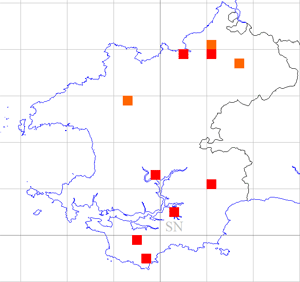Grey Heron - 2017 and 2018 Heronry census counts
 Saturday, December 14, 2019 at 6:00PM
Saturday, December 14, 2019 at 6:00PM A total of 42 nests counted from six heronries counted in 2017.
 Pembrokeshire Avifauna committee | Comments Off |
Pembrokeshire Avifauna committee | Comments Off |  breeding,
breeding,  resident in
resident in  Grey Heron
Grey Heron  Saturday, December 14, 2019 at 6:00PM
Saturday, December 14, 2019 at 6:00PM A total of 42 nests counted from six heronries counted in 2017.
 breeding,
breeding,  resident in
resident in  Grey Heron
Grey Heron  Sunday, September 1, 2013 at 9:07AM
Sunday, September 1, 2013 at 9:07AM Ardea cinerea cinerea
Mathew mentions heronries at Sealyham, Pointz Castle (dispossessed by Cormorants), Slebech (believed colonies from last) and Linney Head. Within the last ten years heronries have been recorded only at the following sites: Llwyngwair (nine nests in 1940, felling destroyed this heronry; in 1948 only four pairs nesting in adjacent wood); Slebech (twelve, 1939, moved to Picton, six nests in 1947); and on cliffs Nolton (three 1939), Solva (one 1940), Pointz Castle (two 1946), Poth Liskey (one, 1928), Ramsey (one 1931, 1932, 1946 and 1948), Goodwick (two 1947), and Fernhill (one 1947).
R.M.Lockley, G.C.S.Ingram, H.M.Salmon, 1949, The Birds of Pembrokeshire, The West Wales Field Society
 Monday, May 7, 2012 at 4:37PM
Monday, May 7, 2012 at 4:37PM Grey herons generally nest in mature trees, deciduous tree species such as oak and beech together with conifers such as Scots pine. Cliff-nesting Grey Herons have been recorded on parts of the St. Brides Bay coast in the 1960’s and 70’s, there have even been instances of ground-nesting (Donovan & Rees, 1994).
Between the 1984-88 and 2003-07 surveys, there have been changes in the distribution and numbers of heronries in the county. The number of tetrads where breeding was confirmed dropped from 10 to 8. The data obtained from the BTO heronries census show that between the two surveys, at least one established heronry was lost, Shipping Wood, which was clear-felled in the late 1990s, and the oldest continuously occupied heronry in the county at Slebech fell into disuse in 1995/96 when the birds relocted to another site on the Western Cleddau.
The heronries census also includes records of single nests in several parts of the county, though these tend to be occupied only sporadically. Such sites were recorded at Templeton, Westfield Pill, Bosherston Lily Ponds and Crygmarren Pool during the 2003-07 survey.
It can be difficult to locate nest sites and to confirm the breeding status of Grey Herons, especially once the leaves have come out on deciduous trees, or in dense conifer plantations where access can be difficult. This could explain the relatively high number of possible breeding records (not included on the maps), especially if these involved pairs nesting singly away from the established colonies. Total numbers of breeding pairs vary from year to year, and it is difficult to accurately estimate the size of the breeding population.
In 2007, the five heronries that were counted as part of the heronries census yielded a total of 35 pairs. In the mid-1990s the number of pairs regularly exceeded 40 and peaked at 60 in 1997. The total breeding population could therefore be somewhere between 40 and 70 pairs. Donovan & Rees (1994) quote a range of between 30 pairs when the population is at a low ebb, e.g. following the harsh winter of 1962-63 and 65 pairs in more favourable times.
Jane Hodges

Fieldwork 2003-07 (based on 490 tetrads)
Red = breeding confirmed = 8 (1.6%)
Orange = breeding probable = 3 (excluded from total)
Total tetrads in which registered = 11
 Sunday, December 11, 2011 at 8:51PM
Sunday, December 11, 2011 at 8:51PM Breeding resident
Heronry sites have shifted widely during recorded times, that at Slebech Park being the only one that has been consistently occupied since Mathew (1894). Total numbers vary, with very cold winters causing increased mortality when ice renders prey inaccessible. The breeding population varies between about 30 pairs when at a low ebb (e.g. in1962) and 65 pairs in more favourable times (e.g. in 1974). However, some colonies declined in the late 1980s despite mild winters and against the national trend. Single pairs occasionally nest away from established colonies and can then be easily overlooked. Colonies vary between five and twenty nests. That at Slebech has contained as many as 46 nests but has decreased in recent years (see Table 4). Herons formerly bred on the cliffs in the Solva—Newgale—Nolton areas of St Bride's Bay and at Linney Head, but this has not been recorded since 1974. A pair nested on the ground at Trefeiddan in 1978.
Grey Herons feed widely across the county, from the outer coast to the smallest inland pool, even exploiting the upper slopes of the Preseli Mountains at frog-spawning time. They disperse widely in the autumn, birds reaching all the offshore islands and on several occasions small parties of juveniles have been seen flying due west out to sea.

Fieldwork 1984-88 (based on 478 tetrads)
Red = breeding confirmed = 10
Total tetrads in which registered = 10 (2.1%)
 Friday, November 11, 2011 at 3:14PM
Friday, November 11, 2011 at 3:14PM 
Red = breeding confirmed
Orange = breeding probable
Yellow = breeding possible
 Friday, November 11, 2011 at 12:57PM
Friday, November 11, 2011 at 12:57PM 
The BTO winter atlas showed that Grey Herons were present in most 10km squares of their known breeding range during the winters of 1981-82, 1982-82 and 1983-84, being equally at home by fresh and salt waters.
The darker the colour, the higher the relative total count for each 10km square. The darkest blue represents over 7 birds.
Graham Rees
 Tuesday, December 28, 2010 at 7:01PM
Tuesday, December 28, 2010 at 7:01PM Species account from M Mathew, 1894, "The Birds of Pembrokeshire and its islands"
